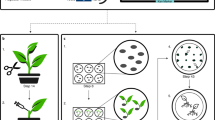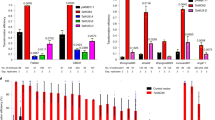Abstract
Collective efforts of several laboratories in the past two decades have resulted in the development of various methods for Agrobacterium tumefaciens–mediated transformation of Arabidopsis thaliana. Among these, the floral dip method is the most facile protocol and widely used for producing transgenic Arabidopsis plants. In this method, transformation of female gametes is accomplished by simply dipping developing Arabidopsis inflorescences for a few seconds into a 5% sucrose solution containing 0.01–0.05% (vol/vol) Silwet L-77 and resuspended Agrobacterium cells carrying the genes to be transferred. Treated plants are allowed to set seed which are then plated on a selective medium to screen for transformants. A transformation frequency of at least 1% can be routinely obtained and a minimum of several hundred independent transgenic lines generated from just two pots of infiltrated plants (20–30 plants per pot) within 2–3 months. Here, we describe the protocol routinely used in our laboratory for the floral dip method for Arabidopsis transformation. Transgenic Arabidopsis plants can be obtained in approximately 3 months.
This is a preview of subscription content, access via your institution
Access options
Subscribe to this journal
Receive 12 print issues and online access
$259.00 per year
only $21.58 per issue
Buy this article
- Purchase on Springer Link
- Instant access to full article PDF
Prices may be subject to local taxes which are calculated during checkout

Similar content being viewed by others
References
Christou, P. Transformation technology. Trends Plant Sci. 1, 423–431 (1996).
Herrera-Estrella, L., Simpson, J. & Martinez-Trujillo, M. Transgenic plants: an historical perspective. Methods Mol. Biol. 286, 3–32 (2005).
Labra, M. et al. Genomic stability in Arabidopsis thaliana transgenic plants obtained by floral dip. Theor. Appl. Genet. 109, 1512–1518 (2004).
Feldmann, K.A. & Marks, M.D. Agrobacterium mediated transformation of germinating seeds of Arabidopsis thaliana: a non-tissue culture approach. Mol. Gen. Genet. 208, 1–9 (1987).
Bechtold, N., Ellis, J. & Pelletier, G. In planta Agrobacterium-mediated gene transfer by infiltration of adult Arabidopsis thaliana plants. C. R. Acad. Sci. Ser. III Sci. Vie Life Sci. 316, 1194–1199 (1993).
Clough, S.J. & Bent, A.F. Floral dip: a simplified method for Agrobacterium-mediated transformation of Arabidopsis thaliana. Plant J. 16, 735–743 (1998).
Desfeux, C., Clough, S.J. & Bent, A.F. Female reproductive tissues are the primary target of Agrobacterium-mediated transformation by the Arabidopsis floral-dip method. Plant Physiol. 123, 895–904 (2000).
Bechtold, N., Jolivet, S., Voisin, R. & Pelletier, G. The endosperm and the embryo of Arabidopsis thaliana are independently transformed through infiltration by Agrobacterium tumefaciens. Transgenic Res. 12, 509–517 (2003).
Chung, M.H., Chen, M.K. & Pan, S.M. Floral spray transformation can efficiently generate Arabidopsis transgenic plants. Transgenic Res. 9, 471–476 (2000).
Curtis, I.S. & Nam, H.G. Transgenic radish (Raphanus sativus L. longipinnatus Bailey) by floral-dip method—plant development and surfactant are important in optimizing transformation efficiency. Transgenic Res. 10, 363–371 (2001).
Cao, M.Q. et al. Transformation of Pakchoi (Brassica rapa L. ssp. chinensis) by Agrobacterium infiltration. Mol. Breeding 6, 67–72 (2000).
Tague, B.W. Germ-line transformation of Arabidopsis lasiocarpa. Transgenic Res. 10, 259–267 (2001).
Wang, W.C., Menon, G. & Hansen, G. Development of a novel Agrobacterium-mediated transformation method to recover transgenic Brassica napus plants. Plant Cell Rep. 22, 274–281 (2003).
Clough, S. Floral dip: an Agrobacterium-mediated germ line transformation. Methods Mol. Biol. 286, 91–102 (2005).
Curtis, I. Production of transgenic crops by the floral-dip method. Methods Mol. Biol. 286, 103–110 (2005).
Koncz, C., Kreuzalerl, F., Kalmanl, Z. & Schell, J. A simple method to transfer, integrate and study expression of foreign genes, such as chicken ovalbumin and α-actin in plant tumors. EMBO J. 3, 1029–1037 (1984).
Cheng, M. et al. Genetic transformation of wheat mediated by Agrobacterium-tumefaciens. Plant Physiol. 115, 971–980 (1997).
Hood, E.E., Gelvin, S.B., Melchers, L.S. & Hoekema, A. New Agrobacterium helper plasmids for gene transfer to plants. Transgenic Res. 2, 208–221 (1993).
Ooms, G. et al. Studies on the structure of cointegrates between octopine and nopaline Ti-plasmids and their tumor-inducing properties. Plant Mol. Biol. 1, 265–276 (1982).
Halluin, D. et al. The bar gene as selectable and screenable marker in plant engineering. Methods Enzymol. 216, 415–426 (1992).
Thorlby, G., Fourier, N. & Warren, G. The SENSITIVE TO FREEZING2 gene, required for freezing tolerance in Arabidopsis thaliana, encodes a β-glucosidase. Plant Cell 16, 2192–2203 (2004).
Acknowledgements
We thank R. Catala-Rodriguez, I.-C. Jang, J. Xu and other members of the Chua laboratory for fruitful discussions. Work in the Chua laboratory is supported in part by US National Institutes of Health grant GM 44640.
Author information
Authors and Affiliations
Corresponding author
Ethics declarations
Competing interests
The authors declare no competing financial interests.
Rights and permissions
About this article
Cite this article
Zhang, X., Henriques, R., Lin, SS. et al. Agrobacterium-mediated transformation of Arabidopsis thaliana using the floral dip method. Nat Protoc 1, 641–646 (2006). https://doi.org/10.1038/nprot.2006.97
Published:
Issue Date:
DOI: https://doi.org/10.1038/nprot.2006.97
This article is cited by
-
Deciphering the regulatory role of PheSnRK genes in Moso bamboo: insights into hormonal, energy, and stress responses
BMC Genomics (2024)
-
Capture of regulatory factors via CRISPR–dCas9 for mechanistic analysis of fine-tuned SERRATE expression in Arabidopsis
Nature Plants (2024)
-
Localized calcium transients in phragmoplast regulate cytokinesis of tobacco BY-2 cells
Plant Cell Reports (2024)
-
PnNAC2 promotes the biosynthesis of Panax notoginseng saponins and induces early flowering
Plant Cell Reports (2024)
-
GhHB14_D10 and GhREV_D5, two HD-ZIP III transcription factors, play a regulatory role in cotton fiber secondary cell wall biosynthesis
Plant Cell Reports (2024)
Comments
By submitting a comment you agree to abide by our Terms and Community Guidelines. If you find something abusive or that does not comply with our terms or guidelines please flag it as inappropriate.



